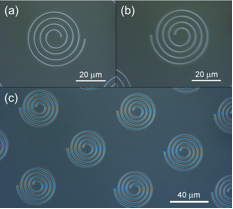THz Optical Activity
Molecular chirality is an important characteristic of many biological systems and is therefore of great interest in biochemical and pharmaceutical research. Examples of chiral systems include amino acids, sugars, proteins, and enzymes. While biomolecules have mainly been studied in solution phase, their solid state properties are important in pharmaceuticals, especially when one polymorph is more biologically active than another. Understanding the chiral properties of organic molecular crystals (OMCs), is an important aspect of our overall research.
The chiral attributes of molecules can be investigated through their interaction with light, or optical activity. The interactions can result in optical rotation, circular dichroism, or both. Optical rotation occurs when there is a difference in the refractive index for left- and right-handed circularly polarized light at a single wavelength. Optical rotatory dispersion (ORD) is the measure of optical rotation over a range of wavelengths. Circular dichroism (CD) is the result of a material absorbing unequal amounts of left- and right-handed circularly polarized light. When circular dichroism is measured in the infrared region where vibrational transitions occur, that is known as vibrational circular dichroism (VCD).
Optical activity of chiral molecules has been well documented by CD, ORD, and VCD measurements in the visible and IR, but no such studies have been documented over a broad spectral range in the THz region. There have been however, studies of THz optical activity of helices1 and chiral lithographic structures.2,3 In general, the extent of optical rotation decreases with an increase in wavelength, meaning that the effect is smaller in the THz region than in the near- and mid-IR.
We recently developed4 a rapid and highly efficient method for determining the frequency-dependent optical activity of a given sample. Figure 1 is a schematic diagram of the experiment, which uses the THz time-domain spectroscopy setup.

Using a test sample of Archimedean spirals (Figure 2), we were able to determine both the polarization rotation and signed ellipticity of each frequency component in the THz pulse (Figure 3). For more information on the development of this technique, please see our publication in APL.


References
- Elezzabi, A. Y.; Sederberg, S., Optical activity in an artificial chiral media: a terahertz time-domain investigation of Karl F. Lindman’s 1920 pioneering experiment. Optics Express 2009, 17 (8), 6600-6612.
- Kanda, N.; Konishi, K.; Kuwata-Gonokami, M., Terahertz wave polarization rotation with double layered metal grating of complimentary chiral patterns. Optics Express 2007, 15 (18), 11117-11125.
- Tzuang, L. D. C.; Jiang, Y. W.; Ye, Y. H.; Chang, Y. T.; Wu, Y. T.; Lee, S. C., Polarization rotation of shape resonance in Archimedean spiral slots. Applied Physics Letters 2009, 94 (9), 3.
- Aschaffenburg, D. J.’ Williams, M. R. C.; Talbayev, D.; Santavicaa, D. F.; Prober, D. E.; Schmuttenmaer, C. A. Efficient Measurement of Broadband Terahertz Optical Activity. Appl. Phys. Lett. 2012, 100, 241114